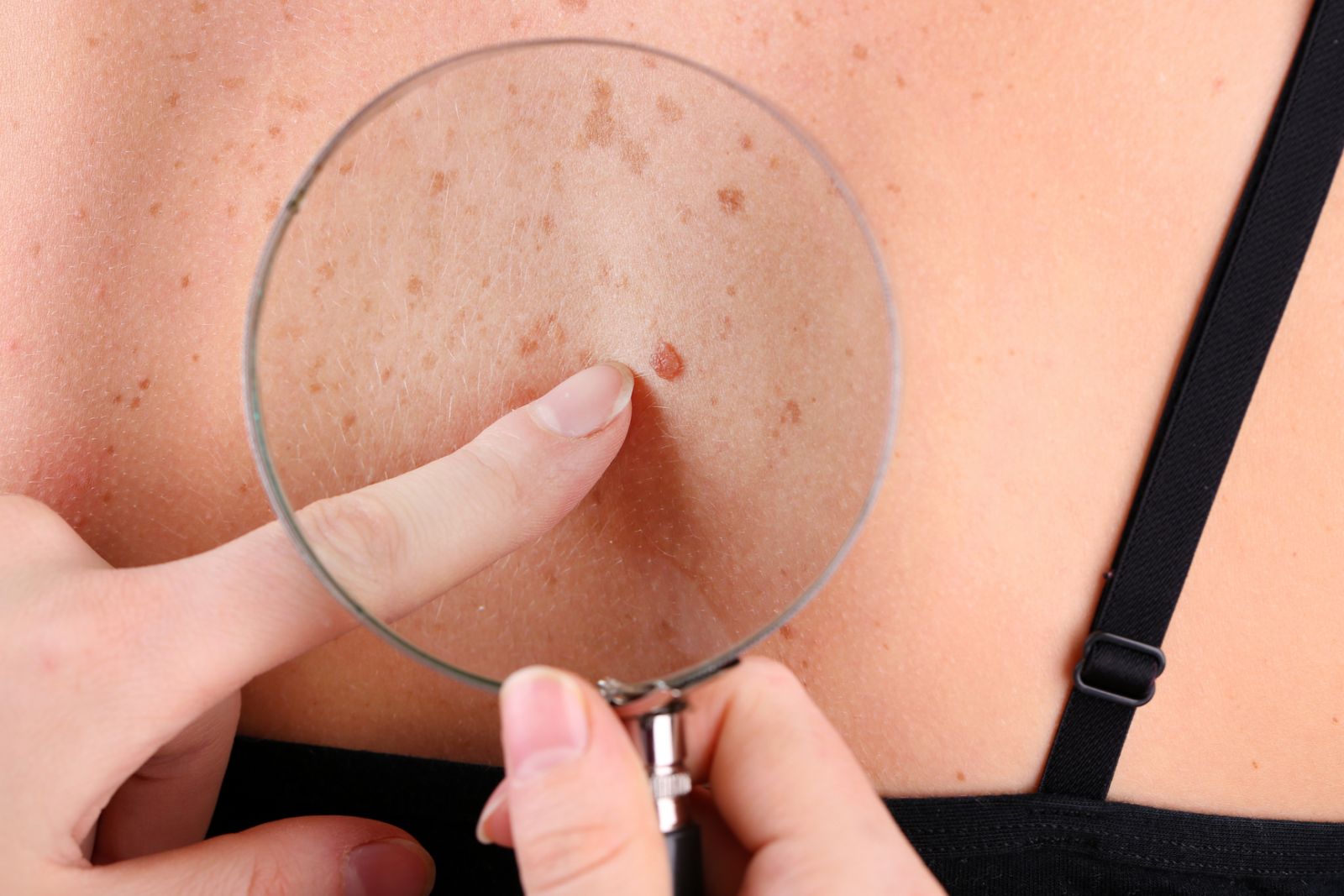Welcome to the DermacenterMD Blog
 A good reminder from the Skin Cancer Foundation. It's important to remember that your family's medical history is crucial to your health.
A good reminder from the Skin Cancer Foundation. It's important to remember that your family's medical history is crucial to your health.
So you're sitting in the dermatologist's waiting room, filling out the usual forms required for a doctor visit. After filling in the basics, you spot the next question and realize you're stumped: it's asking about your family's medical history. Has anyone in your family had melanoma or any other form of skin cancer? Here's why the doctor asks, and what you need to know:
History Could Repeat Itself
A family history of melanoma increases your risk of developing the cancer yourself, according to Ramzi Saad, MD, a board-certified dermatologist and Skin Cancer Foundation member based in Plymouth, Massachusetts. In fact, about one in every 10 patients diagnosed with melanoma has a family member with a history of the disease. When gathering family history, Dr. Saad says, the more information, the better.
"We ask for a history of skin cancers, specifically melanoma, but getting a family history of all cancers is also important," he says. "There are some genetic connections between melanoma and other cancers."
Closer Relative, Higher Risk
Gathering accurate information about multiple family members can be a little intimidating, but Dr. Saad notes a few points that are of particular importance when digging through medical history. The number of relatives that have had melanoma, particularly first-degree relatives like parents or siblings, is a definite need-to-know. Each person with a first-degree relative diagnosed with melanoma has a whopping 50 percent greater chance of developing the disease than people who do not have a family history of the disease.
Saad says the more complete the history, the better, but the number of first-degree relatives with the disease is the most important predictive factor for an increased risk of melanoma.
Take Action
What happens if you do find out that skin cancer runs in your family? Saad recommends extra vigilance for prevention, being sure to use sunscreen every day and avoiding unnecessary sun exposure. He points to our tips on how to perform a self exam, but notes that seeing a dermatologist annually is critical as well.
“A full skin examination by a trained professional can help to identify suspicious lesions needing removal,” Dr. Saad says. A board-certified dermatologist will also be able to help patients keep an eye on lesions that may become cancerous in the future, and establish the appropriate follow-up frequency for that individual’s skin checks.
So in advance of your next skin check, try gathering some info on your family’s medical history. You might be surprised to learn that someone close to you once dealt with skin cancer, and that knowledge can help your dermatologist help you.
For more information about skin cancer see the Skin Cancer Foundations blog: http://blog.skincancer.org/2017/02/22/what-you-should-know-about-your-familys-history-of-melanoma/
If you or someone you know should have their skin checked, give us a call today at 574-522-0265 to schedule an appointment.
 Christmas shopping should not be stressful, yet many of us wait to the last minute to gather our gifts for loved ones and end up feeing the holiday stress. This gift guide is composed for the skin health contious person in your life. Someone that loves to care for their skin, and of course, pamper their skin every once-in-a-while.
Christmas shopping should not be stressful, yet many of us wait to the last minute to gather our gifts for loved ones and end up feeing the holiday stress. This gift guide is composed for the skin health contious person in your life. Someone that loves to care for their skin, and of course, pamper their skin every once-in-a-while.
1. Electronice Facial Cleansing Brush
The Clarisonic is a handheld facial cleansing brush that helps to exfoliate skin and unclog pores, and is perhaps the most popular electronic facial cleansing brush on the market, but it does have a rather heafty price tag. You can remove more makeup and toxins from your skin by using a Clarisonic a few times a week. They come in an array of colors and sets. The Clarisonic can be purchased as www.clarisonic.com or most major department stores such as Macy’s, Nordstrom, or Dillards. Other less-expensive options also exist and can be found at stores like Wal-Mart and Target. You can find an array of less-expensive options by searching "clarisonic alternative."
2. Schedule a Facial
Getting a facial is a real luxury. Often in our busy lives, we don’t take time to pamper ourselves. Schedule a facial for your loved one to help them take time to relax and improve their skin. Popular places to schedule a facial are Origins, Message Envy, or your local spa.
3. Lip Balm with SPF
Most people have a few lip balms laying around the house, but it is important to have a lip balm that contains SPF. Skin cancer can develop on the delicate skin of lips, so it’s important to protect the skin on your lips from the harmful rays of the sun.
There are a wide variety of lip balms with SPF available at most drug stores and department stores.
4. Sunscreen
This may seem like a lame gift, but think about the last time you went to the beach. Where you frantically searching last-minute for the bottle of sunscreen only to find that its almost empty? Having a brand new bottle of sunscreen ready to go for the summer months can be a major help for people who are conscious about protecting their skin from the sun. It is almost certain that they will be grateful for your thoughtfulness.
Sunscreen can be purchased at most drug stores or department stores. Just be sure to check the label and make sure that the sunscreen you are purchasing contains at least one of the following ingredients: titanium dioxide, zinc oxide, and avobenzone (a.k.a. Mexoryl).
5. Sephora Gift Card
If you are doing your last minute shopping and don’t have the time to shop around to decide on a specific gift, just pop in to Sephora and get a gift card. Sephora has many high end skin care lines with every product a skin health conscious person could want. From face wash to anti-aging products and moisturizers, you can never go wrong with a gift card from Sephora. Ulta Beauty is another great option as well, the nice thing about Ulta is they carry both expensive high-end brands, as well as less-expensive drug strore brands.

Check out these intersting and suprising facts about the skin that you may not have known!
- The skin is the bodies largest organ.
- The average person sheds approximately 1.5lbs of dead skin cells each year.
- An average adult has more than 20 square feet of skin.
- A square inch of the human body has about 19,000,000 skin cells and up to 300 sweat glands.
- The eyelids are the thinnest area of skin on the human body.
- Contrary to some beliefs, dust is not made up mostly of dead skin cells. There are many sources of dust pollutants floating around the air.
- Your skin sheds 50,000 cells every minute.
- There are at least five types of receptors in the skin that respond to pain and touch.
- Globally, dead skin accounts for about a billion tons of dust in the atmosphere.
- In blind people, the brain’s visual cortex is rewired to respond to stimuli received through touch and hearing, so they literally “see” the world by touch and sound.
Source: http://www.amazingandweird.com/facts/30-interesting-and-fun-facts-about-human-skin/
 Check out this article from the Skin Cancer Foundation. It's important to remember that people of all skin types and tones can be affected by skin cancer.
Check out this article from the Skin Cancer Foundation. It's important to remember that people of all skin types and tones can be affected by skin cancer.
People who have dark skin tones often believe they're not at risk for skin cancer, but that is a dangerous misconception , says dermatologist Maritza I. Perez, MD, a senior vice president of The Skin Cancer Foundation.
"Anyone can get skin cancer, regardless of race," she says. While incidence of melanoma is higher in the Caucasian population, a July 2016 study in the Journal of the American Academy of Dermatology showed it is more deadly in people of color. African American patients were most likely to be diagnosed with melanoma in its later stages than any other group in the stuy, and they also had the worst prognosis and the lowerst overall survival rate. Most skin cancers are associated with ultraviolet (UV) radiation from the sun or from tanning beds, says Dr. Perez. Yes, darker skin produces more of the pigment called melanin that does help protect skin- but onlyto a certain extent. People of color can still get sunburned, and they can also develop skin cancer from UV damage.
It’s of concern that 65 percent of African American participants in a survey said they never used sunscreen. This needs to change, says Dr. Perez. “Remember, ethnicity does not define skin type. It can represent a wide range of skin tones with a wide range of risks.” To avoid premature aging and damage that can lead to skin cancer, everyone should use sunscreen every day and practice sun-safe habits, such as seeking shade and wearing protective clothing, hats and UV-blocking sunglasses.
Additionally, certain skin cancers are caused by factors other than UV — such as genetics or environmental influences — and may occur on parts of the body rarely exposed to the sun. For example, people who have dark skin are more susceptible to acral lentiginous melanoma (ALM), an especially dangerous form of melanoma that typically appears on the palms of the hands and soles of the feet. (The Jamaican singer and musician Bob Marley died of ALM when he was only 36.)


People who have dark skin are more susceptible to acral lentiginous melanoma (ALM), like these examples above.
It’s crucial to detect skin cancer early, when it is easiest to treat and most likely to be cured. Dr. Perez says she advises people of all ethnicities to do a monthly skin self-exam and see a dermatologist annually — and sooner if any of the warning signs appear:
- A bump, patch, sore or growth that bleeds, oozes, crusts, doesn’t heal or lasts longer than a month. This may indicate basal cell carcinoma.
- An ulcer, scaly red patch, wart-like growth or sore that sometimes crusts or bleeds could be a sign of squamous cell carcinoma. This type of skin cancer can also develop in old scars or areas of previous physical trauma or inflammation.
- New or existing moles that are asymmetrical, have an irregular border, more than one color, are larger than a pencil eraser or change in any way may indicate melanoma. Pay special attention to suspicious spots on the hands, soles of the feet or under the nails, which could signify ALM.
This website includes materials that are protected by copyright, or other proprietary rights. Transmission or reproduction of protected items beyond that allowed by fair use, as defined in the copyright laws, requires the written permission of the copyright owners.
Archive:
Tags
- dry skin (2)
- moisturizer (1)
- sensitive skin (3)
- PA (2)
- Skincare (2)
- skin cancer (29)
- cancer (6)
- facts (1)
- skin (19)
- dermatology (22)
- skin care (19)
- cosmetic (2)
- wrinkles (1)
- Botox (4)
- Dysport (3)
- sleep (1)
- look good (1)
- daily routine (1)
- healthy lifestyle (1)
- doctor (2)
- patient (1)
- sun protection (5)
- sunscreen (14)
- aging dermatology (1)
- providers (1)
- tanning (2)
- sun (6)
- UVA rays (2)
- UVB rays (2)
- melanoma (10)
- Acne (2)
- Treatment (2)
- sunscren (1)
- sun exposure (5)
- Melanoma Monday (2)
- Skin Cancer Awareness Month (1)
- education (2)
- skin cancer specialist (1)
- basal cell carcinoma (1)
- squamous cell carcinoma (1)
- ingredients (2)
- improve your smile (1)
- cosmetics (1)
- laser (1)
- fillers (2)
- sunburn (3)
- avoid the sun (1)
- hat (1)
- sun clothing (1)
- SPF (1)
- Rosacea (3)
- NP (1)
- Nurse Practitioner (1)
- mid-level provider (1)
- physician (1)
- dermatologist (6)
- cosmetic dermatology (4)
- anti-aging (2)
- youthful looks (1)
- Eczema (2)
- rash (2)
- itch (1)
- the rash that itches (1)
- reduce itch (1)
- itching (1)
- getting along with others (1)
- basal cell (2)
- squamous cell (2)
- detection (1)
- Mohs surgery (2)
- photoaging (1)
- Inspiring (1)
- word of the day (1)
- inspiration (3)
- uplifting (1)
- protection (4)
- lips (1)
- reduce wrinkles (1)
- look younger (1)
- encouragement (1)
- never give up (1)
- you can do it (1)
- medical school (1)
- dreams (1)
- brown spots (1)
- moles (2)
- liver spots (1)
- age spots (1)
- Abe Lincoln (1)
- life lessons (1)
- lip cancer (1)
- health (12)
- motivation (1)
- work (1)
- people (2)
- home life (1)
- lifestyle (1)
- ABCDEs of Melanoma (1)
- mole (1)
- skin check (2)
- skin facts (2)
- odd (1)
- fun (1)
- interesting (1)
- lung cancer (1)
- disease (1)
- Christmas (2)
- gifts (1)
- sun burn (1)
- winter skin tips (1)
- itchy skin (1)
- winter skin (1)
- myths (1)
- myth busted (1)
- skin protection (1)
- sunscreen safety (1)
- specialist (1)
- red skin (1)
- irritation (1)
- feel good (1)
- helping (1)
- help (1)
- helping others (1)
- treatment options (1)
- skin health (9)
- Vitamin D (2)
- tanning beds (1)
- skin health. dermatology (1)
- sunshine (1)
- awareness (1)
- prevention (1)
- sun damage (3)
- connections (1)
- working together (1)
- health care (1)
- biotin (1)
- medical (1)
- aging (1)
- elkhart (1)
- Roger Moore (1)
- check (1)
- skin type (1)
- skin cancer prevention (1)
- gift guide (1)
- Christmas gift guide (1)
- Dr. Roger Moore (1)
- holidays (1)
- family history (1)
